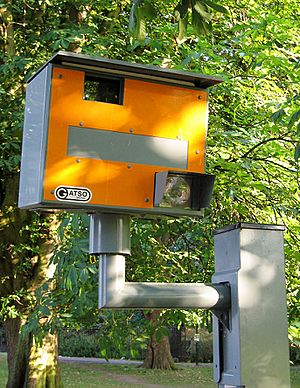Traffic calming facts for kids
Traffic calming is all about making our roads safer. It involves changing roads to help drivers slow down. These changes also make it safer for people who are walking or cycling. The main goal is to create a calmer, safer environment for everyone.
Contents
Why Do We Need Traffic Calming?
Traffic calming helps reduce the number of accidents. When cars drive slower, there's less chance of a serious crash. It also makes neighborhoods more pleasant. People feel safer walking, playing, and cycling near their homes. This can improve the quality of life for everyone in the area.
How Does Traffic Calming Work?
There are many different ways to calm traffic. These methods encourage drivers to reduce their speed. They also make drivers more aware of people around them. Here are some common techniques used to make roads safer:
Speed Control Measures
- Speed bumps: These are raised areas across the road. Drivers have to slow down to go over them comfortably.
- Speed cushions: Similar to speed bumps, but they are smaller. They are designed so emergency vehicles can pass over them easily.
- Speed tables: These are long, flat-topped speed bumps. They raise the entire car to a new level.
- Speed limits: Signs tell drivers the maximum speed allowed. These limits are often enforced by speed cameras. These cameras take pictures of cars going too fast.
Road Design Changes
- Narrowing roads: Making roads seem narrower can make drivers slow down. This can be done with painted lines or by building out the curbs.
- Curb extensions: These are parts of the sidewalk that stick out into the road. They make the road narrower at intersections or crosswalks. This helps pedestrians cross more safely.
- Chicanes: These are curves built into a straight road. They force drivers to steer left and right, which makes them slow down.
- Traffic circles: Small roundabouts at intersections. They make drivers go around a central island, slowing them down.
- Diverters: These block traffic from going straight through an intersection. They force cars to turn, which helps reduce cut-through traffic in neighborhoods.
- Raised crosswalks: These are like speed tables but for pedestrian crossings. They raise pedestrians to the same level as the sidewalk. This makes them more visible to drivers.
Other Methods
- Modal filters: These are physical barriers that allow only certain types of transport through. For example, they might let bikes and pedestrians pass but block cars.
- One-way streets: Changing a two-way street to one-way can simplify traffic flow. This can also reduce speed in some areas.
Benefits of Traffic Calming
Traffic calming has many positive effects. It makes streets safer for everyone, especially kids. It also reduces noise and pollution from cars. This can make neighborhoods quieter and cleaner. By encouraging slower speeds, traffic calming helps create communities where people feel more comfortable walking, cycling, and playing outside.
Images for kids
-
Signing indicating that a motorist is approaching traffic calming devices.
-
Median island with a raised mid-block pedestrian crossing
-
Chicane on a one-lane road












